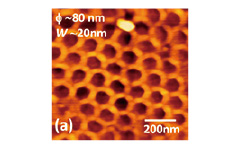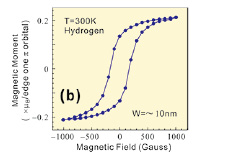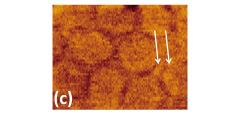Spontaneous Spin Polarization on Pore Edges of Graphene Nanomesh
K. Tada, J. Haruyama, and Y. Iye
Graphene, an ultimate two-dimensional molecule sheet with thickness as thin as one carbon atom size, is attracting significant attention. Although a variety of attractive phenomena has been experimentally reported in graphenes, none has experimentally reported on edge-related phenomena. Basically, there are two kinds of atomic structures of graphene edges; i.e., arm chair and zigzag edges. Theoretically, arm chair edge introduces energy band gap to graphenes, while zigzag edge yields a flat energy band, which makes electrons localize around the edge. The localized electrons are spontaneously spin-polarized due to strong electron interaction arising from extremely high electron density of states (i.e., edge states). It allows research of spin-based phenomena and those applications to novel spintronic devices in spite of a material consisting of only carbon atoms with sp2 orbitals. None has, however, reported on experimental observation of edge-related phenomena, because lithographic fabrication of graphene edges easily introduces defects. Only our group reported on finding of large energy band gaps in low-defect graphene nanoribbons (one-dimensional strip lines of graphenes with two edges along the longitudinal direction), which were fabricated by a non-lithographic method (i.e., derived from unzipping of carbon nantoubes) [1].



Fig. 1. (a) AFM image of a graphene nanomesh with a honeycomb like array of hexagonal nanopores. It was formed by optimized low-power Ar-gas etching using a nano-porous alumina template as a mask. Mean pore diameter φ and inter-pore distance W are ~80 nm and ~20nm, respectively. (b) Room-temperature magnetization of hydrogen-terminated naomesh measured by a superconducting quantum interference device (Quantum Design). (c) Magnetic force microscope image of (b)-sample. Darker parts mean presence of higher densities of polarized electron spins. Arrows indicate polarized spins existing at pore edges.
Here, we report on the other non-lithographic fabrication of graphene edges (Figure 1(a); graphene nanomesh with a honeycomb like array of hexagonal nanopores, which was fabricated using nano-porous alumina template as an etching mask). The method and system allow formation of a large ensemble of low-disorder nanopore edges and nanoribbons (i.e., inter-pore regions). Figure 1(b) shows a result of magnetization measurement of the nanomeshes with hydrogen (H)-terminated zigzag pore edges at room temperature. A ferromagnetic hysteresis loop with large amplitude is clearly observed. In contrast, this feature becomes a diamagnetism like weak hysteresis loop for oxygen-terminated nanomeshes. Bulk graphenes without nanopores show mostly no such features. Observation by magnetic force microscope for the Fig.1(b)-sample is shown in Fig.1(c). Higher densities of spins are evidently confirmed at the inter-pore regions (nanoribbon regions) and also some parts of pore edges (shown by arrows). These results imply that the observed ferromagnetism originates from the H-terminated nanopore edges and also the nanoribbons sandwiched by the pore edges. The observed magnetization value of ~0.3µB per one edge dangling bond is also in quantitatively good agreement with predictions of two theories (i.e., nanoribbon model and Lieb’s theorem).
We cannot yet control fabrication of the zigzag atomic structure of the pore edges. We are just selecting the nanomeshes, which exhibited low D peaks in Raman spectrum after annealing, for the measurement, because it indirectly proves presence of zigzag pore edges. Exact observation of atomic structure of pore edges and its control are indispensable in near future. It is highly expected that the present graphene nanomesh can realize a high-efficiency graphene magnet, which is ultra-light (wearable), flexible, invisible, and rare-element free. Modulating a flat band and introducing polarized spins from pore edges to bulk graphene regions will also open a door to novel all-carbon spintronic devices with strong spin coherence.
References
- [1] T.Shimizu, J.Haruyama et al., Nature Nanotech. 6, 45 (2011) (Selected for Latest highlights, News & Views, and Cover index).
